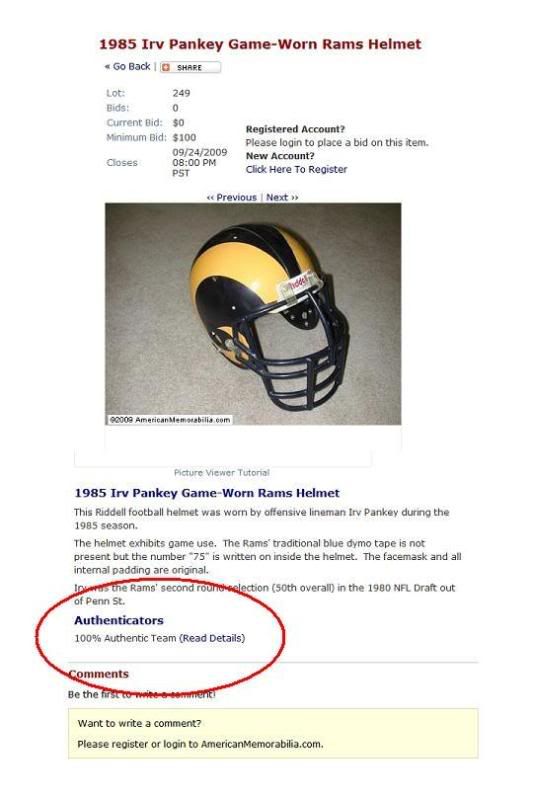Results 1 to 10 of 33
Threaded View
-
09-16-2009, 07:50 AM #1Senior Member

- Join Date
- May 2007
- Posts
- 1,128
New AMI Model = Seller's Authenticate Own Lots?
it appears that ami has moved to a new model that a) includes seller's authenticating their own lots and b) sellers never submitting their lots to ami for inspection but instead keeping them throughout the auction and then shipping them directly to the winning bidder(s).
several ami consignors i've spoken to recently have confirmed this and i think the hodgepodge of lot photo styles and photo backdrops currently on display at ami makes it clear that consignors are taking their own photos of their items and then forwarding these photos onto ami.
needless to say ami's new model begs several questions such as a) what is ami's whopping 20% buyer's premium exactly covering these days if not, at least in part, paying for a professional evaluation to protect bidders b) how many of ami's consignors are actually qualified to evaluate their own items and c) do bidders know that consignors are holding onto their own lots, that they're not in ami's possession (what happens if the seller decides not to send the item after he receives the cash - does the buyer do battle with ami or the seller)? and, of course, another big question is whether or not ami is making any of this perfectly clear to their bidders. my guess would be no.
here's ami's lot 249, "1985 irv pankey game-worn rams helmet".
http://www.americanmemorabilia.com/A...helmet&SortBy=
not only is this helmet not even remotely close to what pankey wore when with the rams (wrong helmet manufacturer, wrong facemask, bogus decals, incorrect decal placement, etc., etc.) but it's not even an authentic rams helmet. this thing is so bad, such a complete mess, that it's actually comical. yet there it is at ami, in all of its glory, being shopped around as an authentic gamer.
the photos that accompany this lot are clearly amateurish, complete with a carpet background, which leads me to believe this is another example of an ami consignor that did his own work on his item, including the evaluation. yet according to the full lot description this item has been evaluated by ami's 100% authentic team. huh? is ami's 100% authentic team now working off of consignor photos? is that the effort ami bidders now get for the 20% premium they fork over? my guess is they don't even get that - my guess is that no qualified person even glanced at this lot.

of course there are some consignors out there that are perfectly capable of evaluating their own lots - in fact i would put more weight in the opinion of some consignors than i would in the opinion of some paid authenticators. for example i noticed that forum member roger gibson has listed some of his very nice items with ami, an example of a consignor perfectly capable of evaluating his own lots.
but do bidders know this is what they're paying for when they agree to ami's 20% premium? or do bidders believe that the 20% fee they're shelling out is earmarked for, at least in part, a professional and impartial third party evaluation? i would say the latter, especially considering ami is still adding "100% authentic team" to the lot descriptions...
imo ami has clearly created a consignor's paradise with their new model - or so it would seem. seller's can keep their items at home without fear of them becoming entangled in ami's financial obligations, they can whip up their own evaluations and then ship out the goods when they get paid. and of course seller's can also take advantage of ami's willingness to engage in hidden reserves - per ami's fine print:
"Unless explicitly stated otherwise by AMI, each Lot is being sold with reserve as a reserve auction... AMI reserves the right to place a bid on any Lot on behalf of the seller up to the amount of the reserve... AMI will not specifically identify bids placed on behalf of the seller."
so a seller can list an item at ami with a starting bid of of $200 and have ami place a $1,000 hidden reserve on it (not to confused with a standard, publicly viewable reserve, i.e. reserve not met / reserve met) - and the bidding audience will have no idea whatsoever that a reserve of a $1,000 has been placed on the item. ami will then bid on the seller's item, on behalf of the seller, as frequently as they deem necessary, up to the amount of the reserve. i'll repeat - ami, the auction house, will place bids on the seller's item up to the amount of the reserve.
and what will the bidding public see prior to the seller's item reaching its reserve? a bunch of bids on the seller's item that would clearly imply an apparent interest in the item. what will the bidding public not see? that ami, the auction house, has placed these bids with the sole intent of bidding up the price and creating the impression of interest, activity and value.
so imo it's quite clear why a consignor might choose ami - but what's not clear to me is why a buyer would choose ami. my guess is that when the word gets out buyers will take their business elsewhere - and the consignors will follow...
...robert







 Reply With Quote
Reply With Quote